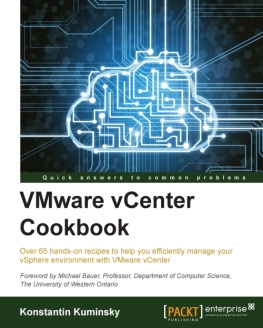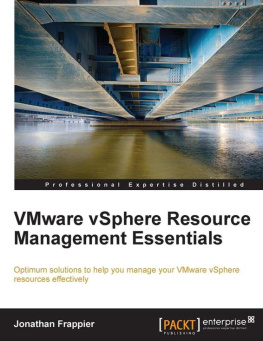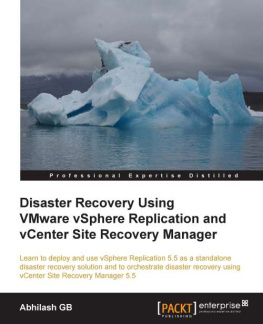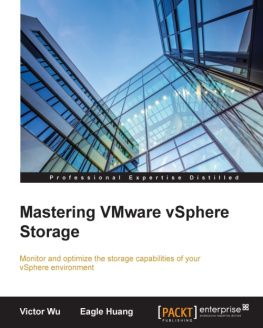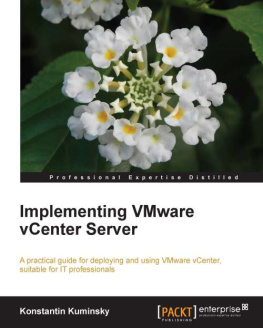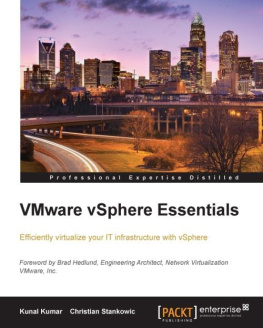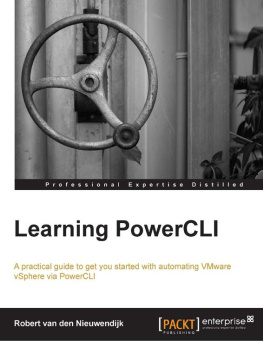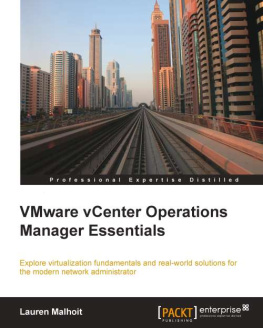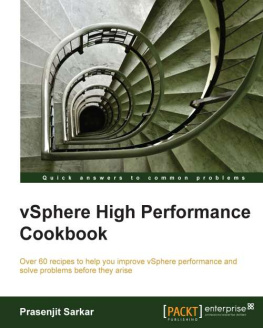Konstantin Kuminsky - VMWare vCenter Cookbook
Here you can read online Konstantin Kuminsky - VMWare vCenter Cookbook full text of the book (entire story) in english for free. Download pdf and epub, get meaning, cover and reviews about this ebook. year: 2015, publisher: Packt Publishing - ebooks Account, genre: Romance novel. Description of the work, (preface) as well as reviews are available. Best literature library LitArk.com created for fans of good reading and offers a wide selection of genres:
Romance novel
Science fiction
Adventure
Detective
Science
History
Home and family
Prose
Art
Politics
Computer
Non-fiction
Religion
Business
Children
Humor
Choose a favorite category and find really read worthwhile books. Enjoy immersion in the world of imagination, feel the emotions of the characters or learn something new for yourself, make an fascinating discovery.
- Book:VMWare vCenter Cookbook
- Author:
- Publisher:Packt Publishing - ebooks Account
- Genre:
- Year:2015
- Rating:4 / 5
- Favourites:Add to favourites
- Your mark:
VMWare vCenter Cookbook: summary, description and annotation
We offer to read an annotation, description, summary or preface (depends on what the author of the book "VMWare vCenter Cookbook" wrote himself). If you haven't found the necessary information about the book — write in the comments, we will try to find it.
Over 65 hands-on recipes to help you efficiently manage your vSphere environment with VMware vCenter
About This Book- Learn how to increase availability and scalability of your virtual environment
- Improve efficiency and optimize resource usage in your virtual infrastructure
- Explore new vCenter features and discover best ways to implement them using proactive examples
If you are a system administrator who has some experience with virtualization and already uses VMware vCenter, but wishes to learn more, then this is the book for you. If you are looking for tips or shortcuts for common administration tasks as well as workarounds for pain points in vSphere administration, youll find this guide useful.
What You Will Learn- Manage your virtual environment faster and in a more efficient manner
- Easily implement and start using new vCenter features
- Scale an existing virtual environment quickly
- Optimize resource usage across virtual infrastructures
- Prioritize VMs with resource pools
- Perform simple and advanced administrative tasks using VMware
- Discover tips on task optimization that will let you have more time for important tasks
VMware vCenter is a centralized management application server that lets you manage virtual machines and ESXi hosts centrally and optimizes resources efficiently. Day-to-day virtual environment administration for IT professionals will become much easier with the help of this book! Clear and helpful recipes and tips offered in this book will help administrators to increase their level of expertise and gain new skills in vSphere administration. You begin by learning useful tasks and features of vCenter such as accessing hosts via SSH and securing host management access. You will then learn ways to ensure 100 percent uptime for critical VMs, protect host redundancy and configure a backup retention policy, all while increasing environment availability. Following this, you will discover how to increase and improve environment scalability and optimize resource usage. Finally, youll finish your journey by learning how to improve environment manageability using CLI, VM cloning, and many other methods.
Konstantin Kuminsky: author's other books
Who wrote VMWare vCenter Cookbook? Find out the surname, the name of the author of the book and a list of all author's works by series.

